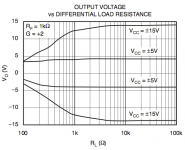not completely true, the dgn package does allow slightly higher real world current output, but requires a pcb cheat to allow soldering by hand in the form of a via under the pad that you fill with solder from underneath to connect to copper pour. the regular soic8 package gets pretty toasty, but still works very well
Last edited:
not completely true, the dgn package does allow slightly higher real world current output, but requires a pcb cheat to allow soldering by hand in the form of a via under the pad that you fill with solder from underneath to connect to copper pour. the regular soic8 package gets pretty toasty, but still works very well
Not exactly a high-current application for the chip, however.
As Brian said, THS4131 in the SOIC package is a good choice. It's bigger, easier to manipulate.
Have you tried a discrete input buffer or just op amps in keeping with the theme.
Have you tried a discrete input buffer or just op amps in keeping with the theme.
Of course, see post #682
Very nice. The B1 was exactly what i was thinking of using. What if any difference was there in the sound over the fully op amp version?
... What if any difference was there in the sound over the fully op amp version?
Less than nuances - it's just that a couple of BF862 are a lot more cheaper than AD797...
2pcs AD AD797 AD797AR on SOIC DIP adapter | eBay
DO i have to worry about fakes with these kind of parts. I know it is a problem with the Jfets floating around on EBAY
DO i have to worry about fakes with these kind of parts. I know it is a problem with the Jfets floating around on EBAY
...DO i have to worry about fakes...
Yes you do - chips are easiest to rebrand/ remark. Ebay is known for fake chips (especially if the price is very low and seller is from China)...
juma,
Do you still have the little BF862 boards you had made? I know its been a while based on the post.
Do you still have the little BF862 boards you had made? I know its been a while based on the post.
Do you mean adapter PCBs (SMD to TH) from the BF862 preamp thread ?
If so, yes I have a couple more.
If so, yes I have a couple more.
After looking at the thread again, I think i can make the bf862 boards myself. Am i correct in thinking that you use the version with the BF862 buffer, driven by your bf862 preamp?
That's the wayAfter looking at the thread again, I think i can make the bf862 boards myself.

Generally, yes. Right now, the main amp is this oneAm i correct in thinking that you use the version with the BF862 buffer, driven by your bf862 preamp?
THis is very similar to the F5, correct. The oonly difference i see is tha you have dropped the protection circuit and the feedback circuit on the front end is different. I understand why you have droppped the protection circuit, since you know enough to not have to worry with them. I don't know that I see an advantage to the different feeback setup on the front end, but I may be missing something. Also, you have dropped the thermistors, which Pass says help with drift. Other than the different fets, am I missing something.
I have boards for two F4 amps and was wandering if it possible to drive them with just opa1632. From datasheet it appears that its output voltage will swing to within 4-5V of the rails, so 15V rails should yield 20V swing, correct.
According to it's datasheet specification OPA1632 swings to within (V-)+1.9V and (V+)-1.9V, respectively, when loaded by 2kOhm. Into 600Ohm this drops to 4.5V within the supply voltage levels.
For a +/-15V supply this would yeld +/-13.1V into 2kOhm and +/-10.5V into 600Ohm. That's 21Vpp into 600Ohm already. 😉
I've attached the diagram showing output voltage vs. load resistance from the datasheet in order to better explain what I mean.
Cheers,
Sebastian.
For a +/-15V supply this would yeld +/-13.1V into 2kOhm and +/-10.5V into 600Ohm. That's 21Vpp into 600Ohm already. 😉
I've attached the diagram showing output voltage vs. load resistance from the datasheet in order to better explain what I mean.
Cheers,
Sebastian.
Attachments
Last edited:
Does anyone have a copy of wensans post and explanation about common mode feedback? apparently the host is no longre carrying the pics.
- Home
- Amplifiers
- Pass Labs
- GC SuperSymmetry
